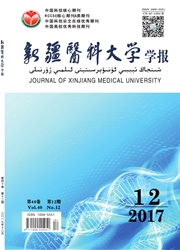

 中文摘要:
中文摘要:
目的了解并掌握塔里木河流域新疆出血热自然疫源地生态系统主要宿主和媒介的群落构成,及其与新疆出血热流行的相关性。方法根据塔里木河流域地理环境特征,在上、中、下游3个区段设立调查研究样方,采集家畜、啮齿动物和蜱类样本,采用生态学方法分析不同生态景观下宿主和媒介的群落结构组成和特征,检测蜱类样本的新疆出血热病毒携带率和家畜抗体携带率,统计分析流行病学的相关性。结果塔里木河流域新疆出血热自然疫源地啮齿动物和蜱类群落组成简单,啮齿动物7种,以子午沙鼠为主,占73.6%,蜱类3种,以亚洲璃眼蜱为主,占98.4%以上:不同地理生态景观上,干旱、半干旱的沙质盐碱地是亚洲璃眼蜱和啮齿动物分布的最优生态景观;空间分布上,亚洲璃眼蜱在优生景观中的数量由上游至下游逐步增加的变化趋势一致,游离蜱指数分别为37.0、44.7和64.7;塔里木河流域上、中、下游3个区段羊血清抗新疆出血热病毒抗体阳性率由13.2%增加至43.1%,自然界中亚洲璃眼蜱病毒分离率由零增加至6.9%,亚洲璃眼蜱指数和羊血清CCHFV(克里米亚刚果出血热病毒)阳性率呈正相关(r=0.992)。结论塔里木河流域新疆出血热自然疫源地呈现丰富的多样性,其自然界新疆出血热流行强度与疫源地宿主媒介及植被构成的丰富度密切相关,可因自然界中亚洲璃眼蜱指数的不同分为不同的流行区。
 英文摘要:
英文摘要:
Objective To understand and grasp community composition of main hosts and vectors in ecosystem of Xinji- ang hemorrhagic fever (XHF) natural foci in the Tarim Rivers and its correlation with XHF epidemicity. Methods Three investigation districts were selected respectively for livestock, rodents and tick samples collection in the up-, mid- and down-stream of the Tarim Rivers according to its geographical environment characteristics. The community composition and structure characteristics of hosts and vectors under different ecological landscapes were analyzed with ecological methods, meanwhile, the carrying rate of Xinjiang hemorrhagic fever virus (XHFV) in tick samples together with antibody positive rate in livestock were also detected, which was utilized to statistically analyze the correlation with epidemiology. Results The community compositions of rodents and ticks were simple in XHF natural foci of the Tarim Rivers, specifically, mainly in- cluding 7 kinds of rodents (Meriones meridianus accounting for 73.6%) and 3 kinds of ticks (Hyalomma asiaticum for 98.4%). Arid and semi-arid saline-alkali sandy soil was the optimally ecological landscape for rodents and Hyalomma asiati- cure. On the spatial distribution, the population of Hyalomma asiaticum in optimal landscapes was gradually increased from upstream to downstream, with the free tick index of 37.0, 44.7 and 64.7, respectively. As for the 3 districts of up-, mid- and down-stream, the positive rates of sheep/goat antiserum against XHFV rose from 13.3% to 43.1%, and the isolation rates of XHFV from Hyalomma asiaticum increased from zero to 6.9%. The index of Hyalomma asiaticum was positively correlated with the positive rate of sheep/goat antiserum to XHFV, with the correlation index (r) of 0.992. Conclusions The Xinjiang hemorrhagic fever natural loci in the Tarim River Basin assumes rich diversity. The epidemic strength of XHFV in nature is closely associated with the diversity and richness of the hosts, vectors as well as vegetation
 同期刊论文项目
同期刊论文项目
 同项目期刊论文
同项目期刊论文
 期刊信息
期刊信息
